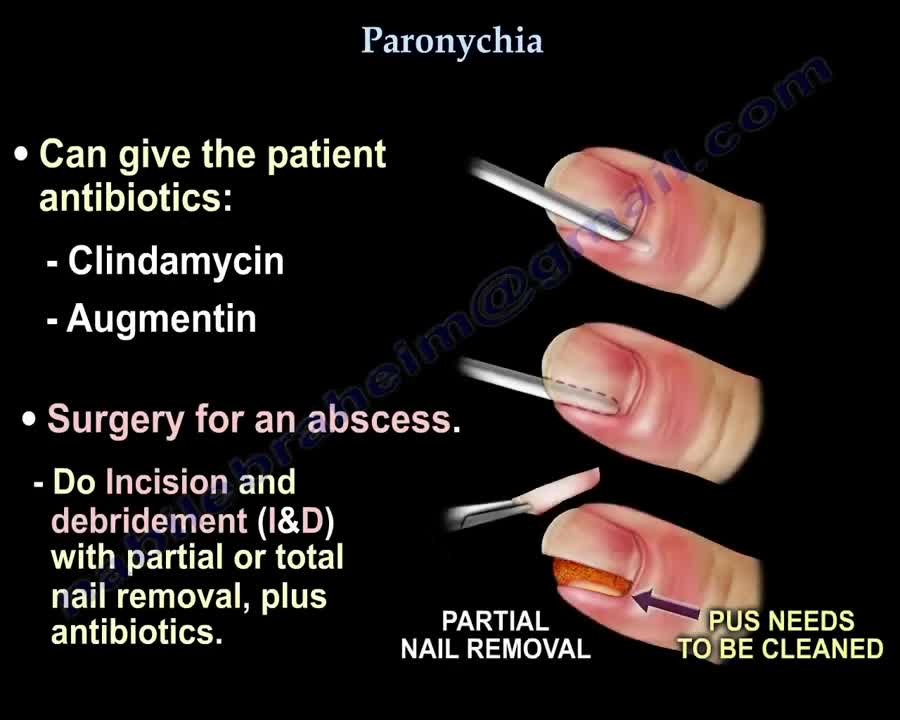Premium Only Content

Paronychia - Everything You Need To Know - Dr. Nabil Ebraheim
Paronychia can be acute or chronic. It is an infection of the nail fold. It is a common hand infection, usually affecting a single digit. The nail fold will be tender, red, and swollen. It will sometimes be fluctuant with pus. It can happen from injury or trauma in the paronychia fold, such as a hangnail, nail pitting, manicuring, or due to thumb sucking. Staphylococcus aureus is the most common organism. If the condition occurs early, do warm soaks. You can give the patient antibiotics such as clindamycin or Augmentin. For abscesses, you will do surgery. Do incision and debridement (I&D) with partial or total nail removal, plus antibiotics. Chronic paronychia is different from acute paronychia. It is a fungal infection of the nail fold. Candida albicans is the most common one. Infection occurs more in diabetics. Multiple fingers can be involved. It does not respond to antibiotics. The infection is rare, but can be recurrent. There is no pus. The nail fold is swollen, inflamed, red, tender, and there is no abscess. Chronic paronychia occurs in people who work with a water environment and chemical irritants such as dish washers, bartenders, gardeners, house keepers, or in dealing with laundry. Risk factors include diabetics, patients who take steroids, and patients who take retroviral drugs such as Indinavir, which causes paronychia in HIV positive patients (the condition resolves when they stop taking the medication). To treat chronic paronychia, avoid water, use topical antifungal agents such as miconozole and topical steroids, and surgery at a last resort. Marsupialization is done in severe resistant cases.
-
 1:29:26
1:29:26
Glenn Greenwald
12 hours agoICE Detains Permanent Resident for Protesting Israel; European Leaders Make Maniacal Rearmament Vows They Cannot Keep | SYSTEM UPDATE #421
138K274 -
 1:02:56
1:02:56
Donald Trump Jr.
14 hours agoUSAID Slush Fund Slashed, X Cyberattack, Plus Interview with Nate Morris | Triggered Ep.223
140K162 -
 5:48:40
5:48:40
Dr Disrespect
18 hours ago🔴LIVE - DR DISRESPECT - THE SHOTTY BOYS - WARZONE, PUBG, FORTNITE
237K43 -
 2:12:50
2:12:50
Adam Carolla
20 hours agoDouble Murder Convict to be executed by Firing Squad + Comedian Elon Gold + Comedian Carol Leifer
94.1K17 -
 46:08
46:08
Kimberly Guilfoyle
15 hours agoBad Day to be a Bad Guy: FBI Taking Down World’s Worst Criminals, Live with John Nantz | Ep.203
195K65 -
 DVR
DVR
Redacted News
14 hours agoWhat's REALLY going on in Syria? | Redacted with Natali Morris
197K134 -
 54:18
54:18
Candace Show Podcast
14 hours agoHarvey Speaks: Jessica Mann & The Five Year Affair | Ep 3
213K88 -
 56:53
56:53
Grant Stinchfield
13 hours ago $9.83 earnedFreeze Spending & Kick the Can Down the Road... Why Republicans Should do Just That!
115K16 -
 56:48
56:48
VSiNLive
13 hours agoFollow the Money with Mitch Moss & Pauly Howard | Hour 1
88.6K1 -
 3:28:27
3:28:27
Barry Cunningham
15 hours agoTRUMP DAILY BRIEFING: INTERNET UNDER ATTACK! X & RUMBLE DOWN! EXECUTIVE ORDER SIGNING!
105K62